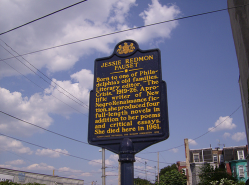Sites of Memory

Philadelphia has received a great deal of popular media and scholarly attention for its pivotal role in American history from the Colonial Era, throughout the American Revolutionary War and National period. It is known as a leading seaport for sea and coastal trading; the site of conventions resulting in both the Declaration of Independence and Constitution; the nation’s first capital city; an early craft artisan, industrial and manufacturing center; and a thriving cultural center noted for its rich diversity of ethnic neighborhoods, performing arts, museums, schools, library, parks and historical landmarks. Throughout the 19th and 20th centuries, Philadelphia’s leading role in the early creation of the United States of America was subsequently reflected in city, county, state and federal government efforts in historical preservation and the creation of many historic landmarks commemorating the multi-faceted legacies of the city as a means of teaching the national American public about itself. The National Park Service’s designation of Constitution and Independence Hall area in central Philadelphia as a national heritage corridor represents the culmination of the city’s seminal legacy of leadership in public education, heritage tourism and historical preservation as means of urban redevelopment throughout the city. School teachers and librarians at every level have utilized these landmarks to support classroom-based and field trip learning activities. Youth organizations, the general public, visitors, and conventioneers also engage these cultural resources through professional or self-guided tours.
This project seeks to build upon Philadelphia’s civic legacy of creating heritage landmarks to preserve and commemorate its many sites of memory for the purpose of educational outreach and the teaching of public history. The virtual reality heritage site and web portal resources will increase the public’s access to and interaction with archival, bibliographic, cartographic, ethnographic, visual and audio content pertaining to historical African American landmarks. The larger appeal of this project for the citizens of Philadelphia and larger national public audiences lies in the fact that it will expand the scope of both the public’s knowledge of these landmarks and their interpretive experience associated with each site of historical geographic memory. These sites represent living history in place; many are anchors of community pride and struggle. The reclamation of lost memories and the ongoing retention of current ones in and about these places is a central feature of this project because of the integration of tools for users to contribute, engage and interpret written, visual, and audio memories about each site. The architectural contours of key spaces or buildings associated with each site will be reconstructed in avirtual world context for users, whether or not they still exist in the contemporary Philadelphia landscape.
